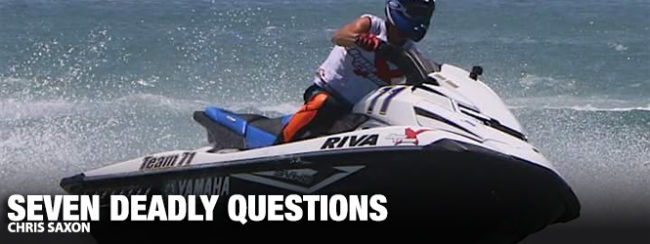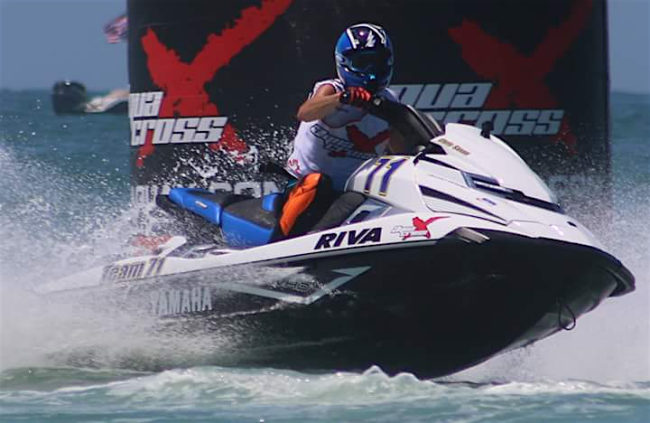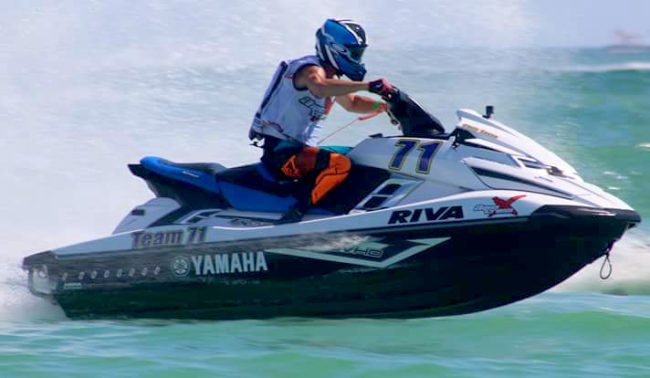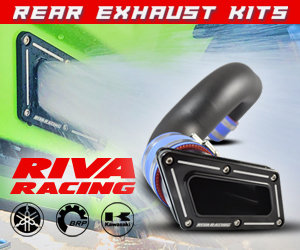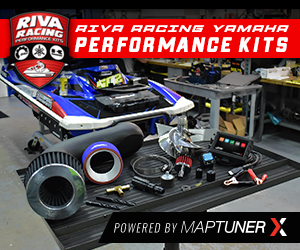The Watercraft Journal: Thanks for meeting with us, Chris [Saxon]. As one of the RIVA Racing Support Team racers, you made a big move this year. How has your transition from Amateur to Professional gone?
Chris Saxon: The transition from Amateur to Pro has been challenging. These guys in the Pro class are all there to win. I knew it would be tough but had no idea how much faster the pace would be. Two races into the season and I’m still trying to get used to it. I came into this year with a lofty goal of being in the Top 10 every weekend, and so far I’m meeting that goal.
WCJ: That’s great! What do you think the main difference between the two is?
CS: One of the biggest differences between Am and Pro is the power and speed of the skis. Compared to a stock ski, these mildly modified skis can be a handful at 75 and 80 MPH, especially for 30 minutes at a time. Another difference is the level of competition. I’m not used to getting passed, much less lapped.
WCJ: So, why did you choose to make the transition?
CS: I chose to move up to the Pro class after winning the Florida 300 class series, and just short of an international series title, last year. I wanted to see how I stacked up with the best riders in the world. If you want to see the best watercraft racers in the world, you need to come to an AquaX race. They have the best races series out there and a world class staff promoting and running it.
WCJ: You mention the difference in the level of machines that racers are riding. What’s the difference in performance parts between the two levels?
CS: Parts are one of the reasons I didn’t want to to move up to the Pro class. In the Amateur class the skis are almost entirely stock. Besides the normal handling modifications like sponsons, intake grate, and ride plate, you’re allowed to install a blow off valve which is supposed to help prolong the life of the supercharger. For the Pro class you can also install an aftermarket prop which will improve hook up, acceleration, and top speed. The one single most important part however is reprogramming the ECU. One of my biggest sponsors, RIVA Motorsports, has made that easy with the Maptuner X. I can reflash my ECU to a race tune at the races and then put it back to stock tune if I just want to cruise around at home.
WCJ: Is there a different strategy in his racing? How has your training changed?
CS: I’m not sure if there is a different strategy, but I do have to make sure I can race at full speed for the whole race. Last year, I could usually get a comfortable lead and put it on cruise control. This year I have to fight all the way to the checkered flag. I’m practicing and training a lot harder this year. I’m usually at Cross Fit 3 or 4 times a week and out riding in the gulf as much as possible.
WCJ: What PWC are you riding this season? Why do you prefer this model?
CS: Well, the first race of the season in Daytona, I was racing a Yamaha GP1800. For the second race I switched back to the Yamaha FX SVHO. It’s not quite as fast as the GP but I feel it’s a better fit for me, especially as choppy as the water can get during a race. The FX is longer and heavier than the GP so it rides a little more steady. No matter if you choose the GP1800 or the FX SVHO, Yamaha WaveRunners make the best skis for racing you far !
WCJ: Who would you like to thank? Sponsors, family, etc.?
CS: I don’t have a title sponsor this year (yet), but I’d like to thank Advanced Carpet Cleaning and Restoration, without them I probably wouldn’t even be racing this year. I’d also like to thank Scott Watkins and Nicholas Goodsell at Yamaha. Also, thanks to Dave Bamdas, Jesus Garcia, and the other guys at RIVA Motorsports for hooking me up with the best go fast parts, and tech support out there. And last but not least I’d like to thank JetPilot, Jettrim, and Fly Racing.





